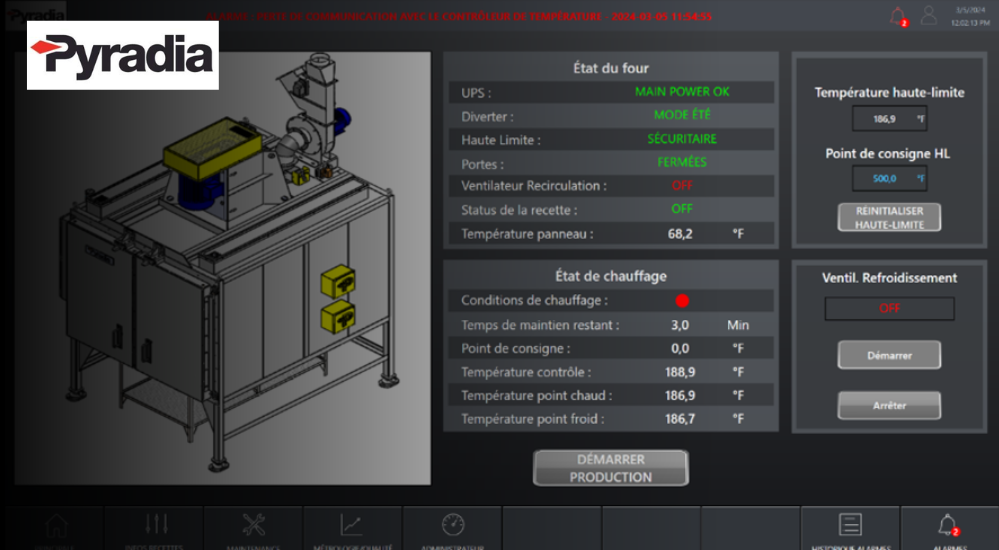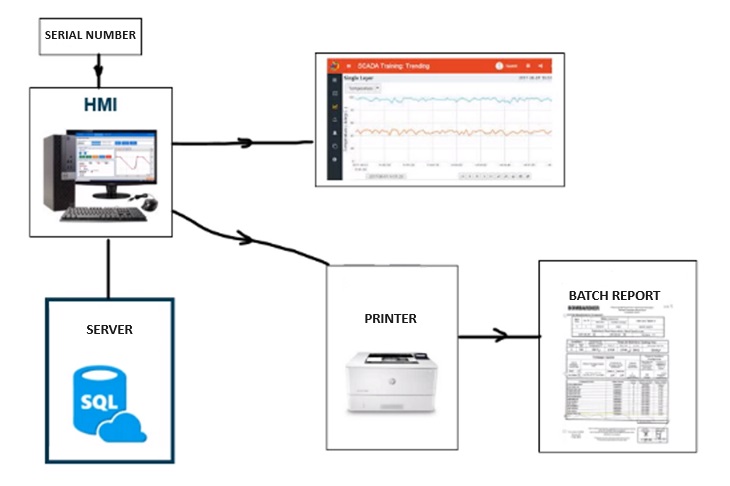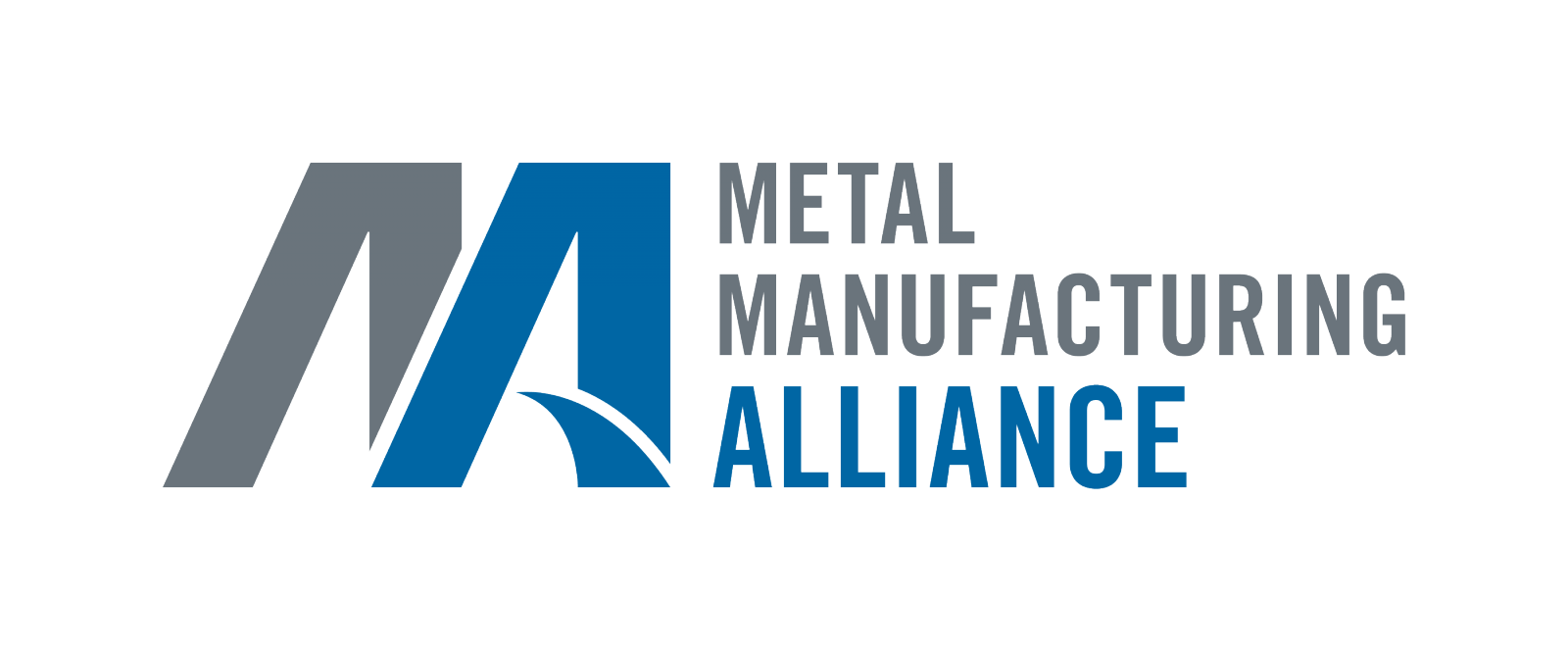
In today's industrial landscape, adopting a Supervisory Control and Data Acquisition (SCADA) system for managing industrial furnace fleets is an essential strategic choice.
Companies use this system for a multitude of essential functions:
-
Process management: Control operations on site or remotely;
-
Human Machine Interface (HMI): Easy interaction with equipment via user-friendly software;
-
Data management: Records, collects, monitors and processes data in real time;
-
Historical analysis: Provides an overview of historical data;
-
Event logging: Accurately records events and data, providing traceability;
-
Automated reporting: Automatically generates detailed production reports.
There are many advantages to integrating a SCADA system:
-
Improved data management: Optimize operations and data processing;
-
Enhanced and simplified visibility: Provides operators with a clear, accessible overview;
-
Enhancing efficiency: Standardizes processes throughout the company;
-
Easy to use: Intuitive centralized control;
-
Reduced downtime: Sends instant alarms in the event of malfunctions or critical situations;
-
Simplified integration: Proposes a pre-tested and validated solution;
-
Unified platform: Centralizes a multitude of data on a single platform;
-
Automatic report generation: Enables automated creation and recording of detailed batch heat treatment reports.
SCADA operation and components
A SCADA system plays an essential role in the control and management of industrial furnaces on a site, while ensuring the collection and recording of crucial data on their operations.
Traditionally, a SCADA system is supplied in the form of software installed on an industrial PC or laptop. This software is then combined with temperature controllers for simple industrial furnaces, and/or PLCs (Programmable Logic Controllers) for more complex furnaces with multiple mechanical components and programmed operating sequences.
What's more, a SCADA system must be accompanied by a Human Machine Interface (HMI), made up of screens used by operators to interact with the SCADA system. This intuitive interface facilitates communication between operators and the system, guaranteeing efficient management and optimum operation monitoring.
Case study: process automation at Pyradia
Pyradia recently set up a SCADA system for a major aeronautics manufacturer. The project modernized the furnace enclosure control, automated heating sequences, temperature monitoring and real-time production data recording via a SCADA interface and an industrial PC.
This system included:
-
A PLC (Programmable Logic Controller) to control operations
-
A 10-inch HMI display for a simple user interface
-
A SCADA program based on the Movicon platform for data management
-
Movicon software license
-
An industrial PC for displaying commands, alarms and production data, and for saving data to a local or remote database
-
A barcode reader for precise identification
-
Ethernet/IP network for data communication
-
Remote access modules for remote customer support
-
Uninterruptible power supply (UPS) to ensure system continuity in the event of a power failure
-
CSA-certified electrical components for safety
-
This system has optimized operations and ensures efficient and secure management of the production process.
Batch production data for SCADA
Batch production data for SCADA includes the following information:
-
Type of operation: annealing, solution treatment or aging
-
Heat treatment load / batch number: identifies each production batch
-
Operating date: date on which the batch is processed
-
Number of parts in a batch: quantity of parts in each batch, entered manually or via barcode scanner
-
Loading time: time at which the batch is introduced into the furnace
-
Convection furnace number: furnace identifier, entered manually or preconfigured
-
Soaking temperature: temperature at which parts are soaked, entered manually or via a barcode scanner
-
Start of soaking time: time at which the thermal process is started, recorded by the PLC system
-
End of thermal process time: time at which parts are removed from furnace, recorded by the PLC system
These data enable efficient management of the production process and guarantee the quality of the end products.

Figure 1 - Processing production batch data

Figure 2 - Processing temperature batch data

Figure 3 - Processing batch data reports

Figure 4 - Example of a batch data report

Figure 5 - Example of an operator interface for a Pyradia furnace
SCADA implementation service
Pyradia's technical department specializes in the implementation of SCADA systems, with recognized expertise in the management of small and large-scale automation projects. As a Rockwell Automation Silver OEM partner, we have demonstrated our ability to deliver quality solutions.
Our sales team or technical department are here to help you! Discover all the SCADA implementation options available to you. We're here to help you find the best solution.

.jpg)





